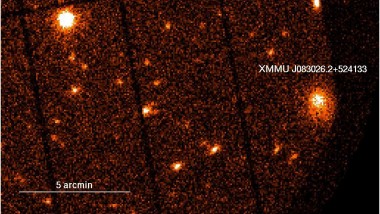Wi-Vi demo (Credit: MIT) It might not be Superman’s X-ray vision, but researchers from MIT are working on a technology which could track humans moving behind walls using inexpensive WIFI technology. Several companies have been working on developing technologies that ...
APS Helps Answer Key Questions About Common Cold
Researchers from the U.S. Department of Energy’s Argonne National Laboratory have recently mapped the atomic structure of a single virus, using a device called the Advanced Photon Source. Their work might lead to future medical solutions, reducing the number of ...
NASA Witnesses a Galactic Spectacle
NASA has recently released a marvelous image of two tangled galaxies, captured using three different telescopes: the Chandra X-ray Observatory, the Hubble Space Telescope, and the Spitzer Space Telescope. A new image of two tangled galaxies has been released by ...
Unpeeling Atoms and Molecules from the Inside Out
An international team of scientists recently published surprising results regarding atoms’ structure, showing that it’s possible to create “hollow” atoms by stripping electrons one-by-one. Their work used one of the world’s most powerful X-ray lasers, located at the Department of ...
3D X-Ray Images Get Closer to Reality
Researchers at the University of Nebraska-Lincoln (UNL) and several Russian colleagues have made significant strides toward coherent, three-dimensional x-rays that could lead to real-time three dimensional medical imaging. The scientists focus an optical laser into concentrations of gas, causing them ...
Milky Way’s Particle Accelerators
Researchers from the Astronomical Institute at Utrecht University have been observing the Milky Way’s particle accelerators. Using data from NASA’s Chandra X-Ray Observatory and European Southern Observatory’s (ESO) Very Large Telescope, the researchers have determined that cosmic rays from our ...
Scientists Detect Luminous X-ray Galaxy Cluster
Astronomers from the Astrophysikalisches Institut in Potsdam, Germany, discovered the most luminous X-ray cluster ever to be detected at a distance of nearly 8 billion light years away from Earth. Only a handful of galaxy clusters are believed to exist ...
SXS – X-Ray on the Universe
NASA has recently approved the construction of the High-Resolution Soft X-Ray Spectrometer (SXS), an instrument devised to study the extreme environments of the universe. The new instrument will help researchers explore dark matter on a large scale as well as ...
Pipsqueak Star Unleashes Monster Flare
On April 25th, 2008, NASA’s Swift satellite picked up the brightest flare ever seen from a normal star other than our Sun. The flare, an explosive release of energy, packed the power of thousands of solar flares theoretically, was visible ...
Swift Catches Exploding Star
NASA’s scientists recently used the Swift Satellite in order to see a star explode and become a supernova. Although over the past 100 years astronomers have observed thousands of supernovas, every time it was seen, it was only after the ...










